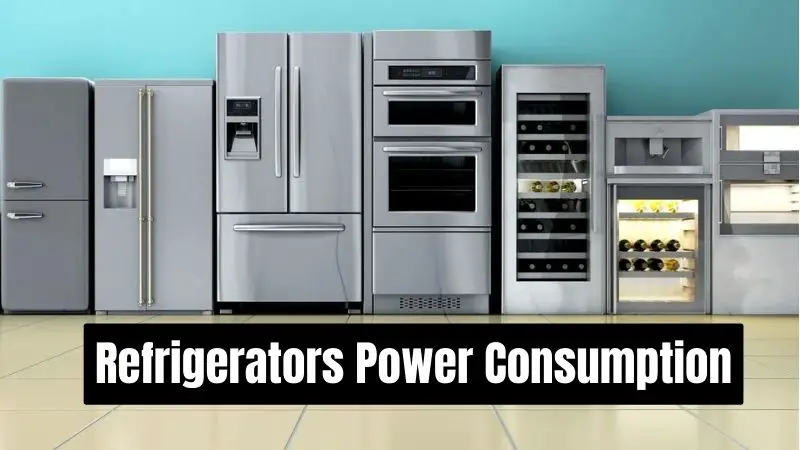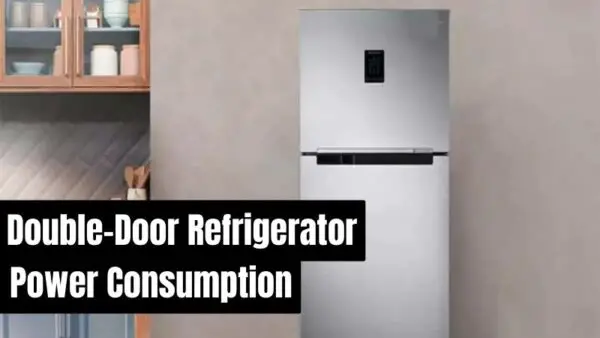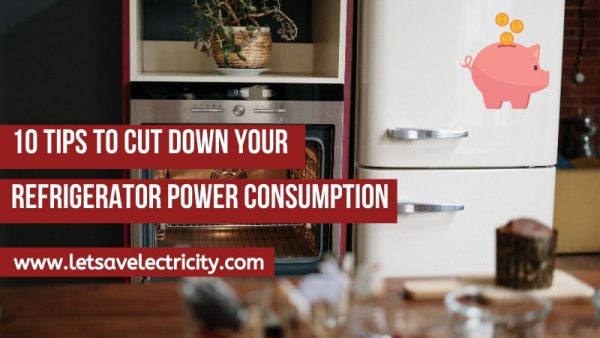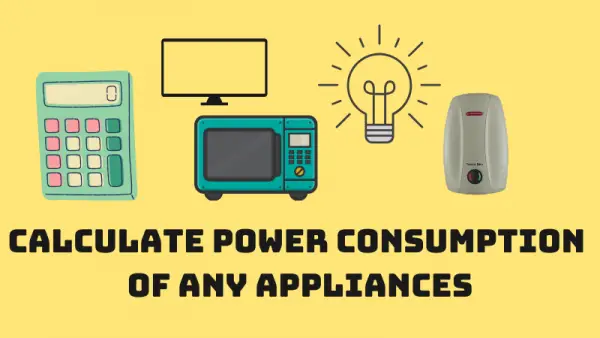In this article, we will see how to calculate the power consumption of a refrigerator, compare the power consumption of single-door refrigerators with double-door, compare the power consumption of old refrigerators with new ones, look at the power consumption of mini coolers, deep freezers, wine coolers, and also go through some useful tips to reduce refrigerator’s power consumption.
Modern refrigerators are energy-star rated and they come with energy-efficient inverter compressors, hence, they don’t consume a lot of electricity.
Generally, the bigger the capacity of a refrigerator, higher the power consumption. The annual power consumption of refrigerators can be as low as 100 kWh and as high as 500 kWh, which is not too high keeping in mind they run 24 X 7 throughout the year.
However, old refrigerators which are not energy-star rated, consume a lot of electricity.
A modern refrigerator will consume less than half of what a 10 – 15-year-old refrigerator of the same capacity will consume.
Since this is a long post here is a quick rundown of what you can expect.
I have gone through a bunch of e-commerce sites and browsed through almost every refrigerator from small single doors, and mini-fridges to big deep freezers and french door fridges, and tabulated each of their annual power consumption.
I have also done comparisons between the power consumption of old refrigerators with new ones, and a single-star refrigerator with five stars.
Also, in the end, you will find 2 simple ways to calculate the power consumption of any refrigerator.
Hence, feel free to skip to the part you are interested in.
Power consumption of Single Door Refrigerators:
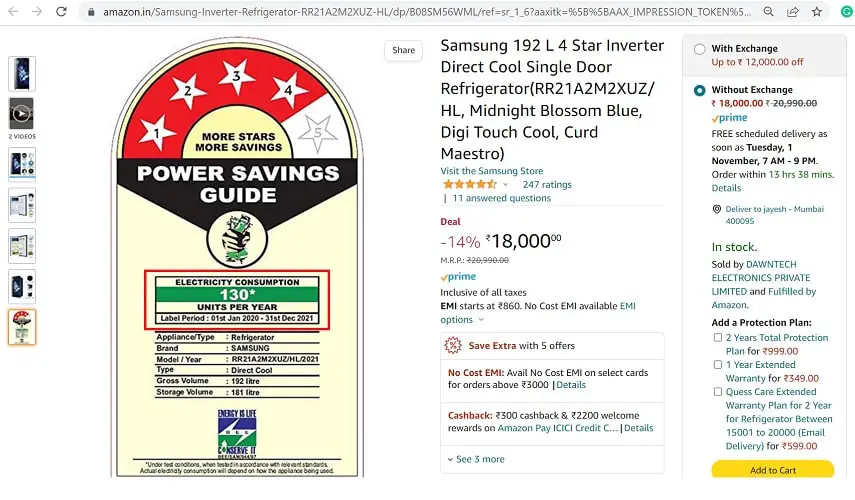
As you can see from the above image, you can go to any e-commerce website and search for a refrigerator and find its energy-saving label which shows its annual power consumption.
I have gone through a bunch of websites and built the following table that shows the annual power consumption of single-door refrigerators from Samsung.
Make: Samsung
| Refrigerator Size | Annual Power Consumption (kWh) |
|---|---|
| 192 ltr (1 star) | 254 kWh |
| 192 ltr (2 star) | 203 kWh |
| 192 ltr (3 star) | 162 kWh |
| 192 ltr (4 star) | 130 kWh |
| 198 ltr (4 star) | 131 kWh |
| 198 ltr (5 star) | 104 kWh |
| 225 ltr (5 star) | 107 kWh |
For comparison, I have built the following table that shows the annual power consumption of single-door refrigerators from LG.
Make: LG
| Refrigerator Size | Annual Power Consumption (kWh) |
|---|---|
| 190 ltr (3 star) | 164 kWh |
| 190 ltr (4 star) | 131 kWh |
| 204 ltr (4 star) | 129 kWh |
| 204 ltr (5 star) | 105 kWh |
| 215 ltr (4 star) | 139 kWh |
| 215 ltr (5 star) | 107 kWh |
| 235 ltr (3 star) | 169 kWh |
| 235 ltr (4 star) | 143 kWh |
| 270 ltr (3 star) | 174 kWh |
A few things to notice from the above tables are,
- As the number of energy-saving stars increases the power consumption decreases by around 20 %. The 192 ltr (1-star) refrigerator from Samsung consumes 254 kWh, whereas, the 192 (2-star) refrigerator consumes just 203 kWh (roughly 20% less than the 192 ltr (1-star) fridge).
- By the time you go from 1-star to 4-star refrigerators, the power consumption is reduced by half. The 192 ltr (1-star) refrigerator from Samsung consumes 254 kWh, whereas the 192 ltr (4-star) refrigerator consumes just 130 kWh (almost half of what 1 star consumes).
- The power consumption of a specific capacity refrigerator from different manufacturers is almost the same. A 192 ltr (3-star) refrigerator from Samsung consumes 162 kWh, whereas the 192 ltr (3-star) refrigerator consumes 164 kWh.
Now let’s look at slightly bigger size refrigerators.
Power consumption of Double Door Refrigerators:
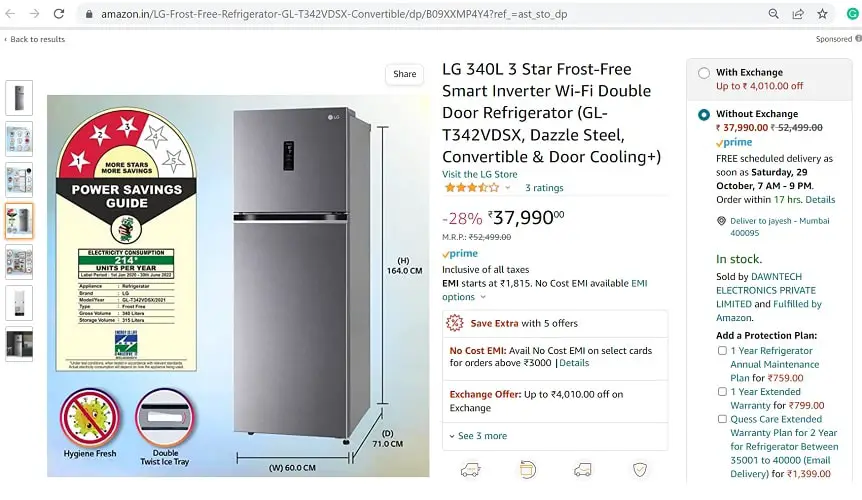
The following table shows the annual power consumption of double-door refrigerators from Samsung.
Make: Samsung
| Refrigerator Size | Annual Power Consumption (kWh) |
|---|---|
| 253 ltr (2 star) | 243 kWh |
| 253 ltr (3 star) | 195 kWh |
| 275 ltr (3 star) | 199 kWh |
| 314 ltr (2 star) | 258 kWh |
| 345 ltr (3 star) | 212 kWh |
The following table shows the annual power consumption of double-door refrigerators from LG.
Make: LG
| Refrigerator Size | Annual Power Consumption (kWh) |
|---|---|
| 260 ltr (3 star) | 198 kWh |
| 340 ltr (3 star) | 214 kWh |
| 360 ltr (3 star) | 217 kWh |
| 423 ltr (3 star) | 229 kWh |
| 630 ltr (3 star) | 253 kWh |
A few things to notice from the above tables are,
- For double-door fridges as well, as the number of energy-saving stars increases the power consumption decreases by around 20 %.
- As the volume of the refrigerator increases, the power consumption also increases, however, the increase is not linear. A 340 ltr (3-star) refrigerator consumes 214 kWh, but a 630 ltr (3-star) refrigerator consumes just 253 kWh. Hence, even though the volume is almost doubled the power consumption increased by just 20%.
- Thus, bigger capacity fridges are more energy efficient than smaller ones, as cooling one unit volume of space in a bigger refrigerator requires much less energy than smaller ones.
Power Consumption Of French Door Refrigerators:
I couldn’t find the annual power consumption of a lot of french door refrigerators, here are a few I found from Samsung:
Make Samsung
| Refrigerator Size | Annual Power Consumption (kWh) |
|---|---|
| 580 ltr | 250 kWh |
| 700 ltr | 500 kWh |
The following table shows the annual power consumption of French Door fridges from LG:
Make: LG
| Refrigerator Size | Annual Power Consumption (kWh) |
|---|---|
| 674 ltr | 317 kWh |
| 688 ltr | 374 kWh |
Single-door, double-door, and french door refrigerators are the most common type of refrigerators used in households.
As we are done with them, let’s look at the power consumption of mini-fridges, wine coolers, and deep freezers.
Power Consumption of A Mini Fridge:
Despite their small size Mini-fridges consumes almost the same amount of power when compared to a much bigger single/double door refrigerator.
Hence, If space and a slightly higher upfront cost investment is a big problem for you then go with a mini fridge.
The following table shows the annual power consumption of a Mini-Fridge.
Mini Fridge Model – Midea- manual defrost model (Source – amazon)
| Mini Fridge Size | Annual Power Consumption of Mini Fridge |
|---|---|
| 1.6 Cu.ft (45 Ltr) | 207 kWh |
| 2.4 Cu.ft (68 Ltr) | 213 kWh |
| 3.4 Cu.ft (96 Ltr) | 219 kWh |
| 4.4 Cu.ft (125 Ltr) | 226 kWh |
As you can see from the above table, a 125 ltr mini-fridge consumes around 226 kWh in a year, which is very high when compared to a 345 ltr (3-star) double-door refrigerator from Samsung that consumes just 212 kWh.
The 345 ltr double-door fridge has almost 3 times more capacity than the 125 ltr mini fridge and it still consumes less power than it.
I have written a dedicated article on the power consumption of mini-fridges, to know more check out my article – Power consumption of mini-fridges.
Power Consumption Of A Wine Cooler:
Wine coolers come in almost identical size options as mini-fridges, and their power consumption is almost similar to mini-fridges.
What makes them different is the temperature range it operates in, while a regular fridge will typically have a temperature range of 40°F or lower a wine fridge will have a range between 45°F and 65°F.
You can check out this article to know more about the difference between wine coolers and mini-fridges.
The following table shows the annual power consumption of wine coolers.
Make: Kalamera (Source: Home Depot)
| Wine Cooler Size | Annual Power Consumption of Wine Cooler |
|---|---|
| 1.8 Cu.ft (50 Ltr) | 186 kWh |
| 2.0 Cu.ft (56 Ltr) | 203 kWh |
| 4.8 Cu.ft (135 Ltr) | 333 kWh |
| 6.3 Cu.ft (178 Ltr) | 396 kWh |
| 6.9 Cu.ft (195 Ltr) | 453 kWh |
To know more about the power consumption of wine coolers, check out my article – Power consumption of wine coolers.
Power Consumption Of A Deep Freezer:
The following table shows the annual power consumption of chest freezers or deep freezers.
(Source: Amazon & Home Depot)
| Chest Freezer Size | Annual Power Consumption of Chest Freezer |
|---|---|
| 3.5 Cu.ft (100 Ltr) | 193 kWh |
| 5.0 Cu.ft (142 Ltr) | 218 kWh |
| 7.0 Cu.ft (200 Ltr) | 250 kWh |
| 11 Cu.ft (311 Ltr) | 280 kWh |
| 14.8 Cu.ft (420 Ltr) | 296 kWh |
| 19.8 Cu.ft (560 Ltr) | 361 kWh |
| 21.7 Cu.ft (614 Ltr) | 346 kWh |
| 24.8 Cu.ft (700 Ltr) | 424 kWh |
To know more about the power consumption of deep freezers or chest freezers, check out my article – Power consumption of deep freezers/chest freezers.
Till now we have seen the annual power consumption of almost every type of refrigerator, however, if you want to calculate the power consumption of your refrigerator manually and don’t want to go by the energy-saving label, then here’s how it’s done.
Calculate The Power Consumption of A refrigerator:
Calculating the power consumption of a refrigerator (for that matter any electrical appliance) depends on two main things,
- First is the wattage of your refrigerator,
- And second is the electricity tariff in your area.
Let us quickly see what these terms are.
If you already know these terms and just want to use the calculator then please scroll down to see the power consumption table and use the calculator.
What is the Wattage of A Refrigerator:
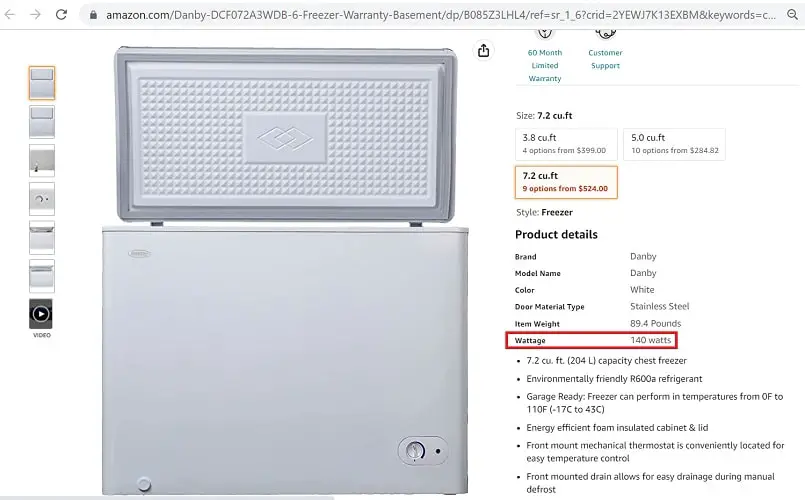
The wattage of a refrigerator varies from 50 watts to 300 watts, generally, the bigger the capacity, the higher the wattage, and the more the power consumption.
You can find the wattage of your refrigerator by reading the label on its compressor, or read its manual or just look for your refrigerator on amazon or the manufacturer’s website and you will find its wattage in the description section.
Sometimes you will find, voltage and current written on the back of your refrigerator’s compressor, just multiply both of them to find the rated power. (Power = Voltage [V] X Current [I] )
One thing to keep in mind is,
In all refrigerators, irrespective of the size and type of refrigerator, its compressor consumes almost 80% to 90% of the electricity. Luckily, even though our refrigerators run 24 X 7, its compressor does not run all the time.
At max, the compressor of a refrigerator runs for 25% to 30% of the time (duty cycle). Hence, in a day (24 hours) the compressor will only for 6 hours to 8 hours at max.
If this whole talk about wattage and electricity is confusing you then here is a quick explanation about what is watt.
Watt is the unit of power. It means the rate at which electricity is consumed or produced by a device. For example, a 50-watt TV consumes power at a rate of 50 watts per hour, it does not mean that the TV consumed 50 units of electricity, it means it will consume power at a rate of 50 watts every hour.
What is Your Electricity Tariff:
In simple words, electricity tariff is the amount your electricity provider charges you for one kWh (unit) of electricity. I live in Mumbai, India here the electricity tariff is Rs 10/kWh.
(What is a Kilowatt hour (kWh) – Kilowatt hour or unit of electricity is the energy consumption of a device. For example, a 50-watt fan running for 50 hours will consume 50 watts x 50 hours = 2500-watt hours = 2.5-kilowatt hours of electricity = 2.5 units of electricity. (1 kWh of electricity = 1 unit of electricity))
To find your electricity tariff, just look into your previous month’s electricity bill and find out your monthly electricity consumption, then just divide your monthly electricity consumption by your total monthly electricity bill, the figure you get is approximately your electricity tariff.
I have put together the following table that shows the electricity tariff of a few countries.
Electricity Tariff Around The World:
| Country | Electricity Tariff | Country | Electricity Tariff |
|---|---|---|---|
| United States | $ 0.154/kWh | India | Rs 6/kWh |
| United Kingdom | £ 0.27/kWh | Germany | € 0.44/kWh |
| Canada | C$ 0.30/kWh | Philippines | ₱ 9.70/kWh |
| Australia | A$ 0.32/kWh | South Africa | R 2.558/kWh |
You can also check out the following resources to know your electricity tariff:
- https://www.globalpetrolprices.com/electricity_prices/
- https://www.statista.com/statistics/263492/electricity-prices-in-selected-countries/
How To Calculate Electricity Consumption of A Refrigerator:
With the knowledge of your refrigerator’s wattage, just use this simple formula to calculate its power consumption.
Power consumption of an appliance = Wattage of an appliance X operational hours.
Cost to run an appliance = Power consumption of an appliance X electricity tariff.
(Operational hours is basically the number of hours you are using your refrigerator)
Let me show you an example,
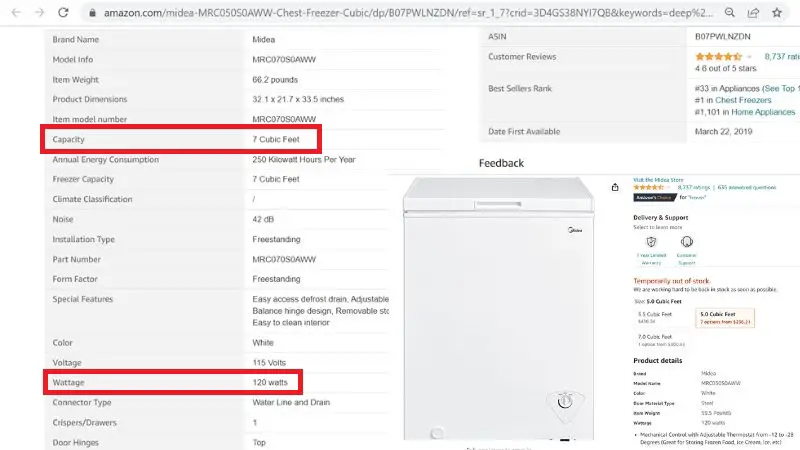
I have selected a 7.0 Cu.ft (200 ltr) 120-watt chest freezer listed on home depot. Let’s assume we will be using it 24 X 7 throughout the year.
Hence, we will calculate the daily, monthly, and annual power consumption of this 120-watt deep freezer.
As I explained before, the compressor in a refrigerator (which consumes the majority of the electricity) only runs 25% to 30% of the time, which means it runs between 6 hours to 8 hours a day.
Hence, while calculating, we will consider the daily operational hours as 6 hours instead of 24 hours, even though the deep freezer will be running for 24 hours a day.
Now let’s calculate,
Electricity consumption of A Chest Freezer:
In our case, wattage is 120-watt and operational hours are 6 hours in a day (since the compressor runs for only 25% of the time), 180 hours in a month, and 2,190 hours in a year.
Hence by using the above formula.
- Daily power consumption of a 7.0 Cu.ft (200 ltr)120-watt chest freezer is = 120-watt X 6 hours = 720 wh.
- Similarly, the monthly power consumption of a 7.0 Cu.ft (200 ltr) 120-watt chest freezer is = 120-watt X 180 = 21.6 kWh.
- Annual Power consumption of a 7.0 Cu.ft (200 ltr) 120-watt chest freezer is = 120-watt X 2,190 = 262.8 kWh.
In the above image, we saw the annual power consumption of a 7.0 Cu.ft (200 ltr) 120-watt chest freezer is equal to 250 kWh, and using this calculation method, we got the annual power consumption of a 7.0 Cu.ft (200 ltr) 120-watt chest freezer to be 262.8 kWh.
Hence, it’s safe to say our calculations are pretty accurate.
Now that you know the power consumption just multiply it by your electricity tariff and you will get to know the cost to run your chest freezer.
For our example,
In Mumbai, the electricity tariff is around Rs 10 per kilowatt hour (kWh), hence it will cost around Rs 216 (21.6 kWh X Rs 10) to run this 120-watt chest freezer for 24 hours every day for an entire month.
Similarly, I have calculated the cost to run this 120-watt chest freezer for 24 hours daily throughout the entire year in the US, UK, New Zealand, Canada, Australia, and Mumbai.
(Remember, the compressor runs for only 25% of the time, 6 hours a day)
| Country (Tariff) | Daily Power Consumption of a Chest Freezer (120-watt) | Monthly Power Consumption of a Chest Freezer (120-watt) | Annual Power Consumption of a Chest Freezer (120-watt) |
|---|---|---|---|
| Los Angeles (25.8 c/kWh) | 0.72 kWh, cents 18.57 | 21.60 kWh, $ 5.57 | 262.8 kWh, $ 67.80 |
| London (36p/kWh) | 0.72 kWh, pence 25.92 | 21.60 kWh, £ 7.77 | 262.8 kWh, £ 94.61 |
| New Zealand (NZ$ 0.304/kWh) | 0.72 kWh, NZ$ 0.21 | 21.60 kWh, NZ$ 6.56 | 262.8 kWh, NZ$ 79.89 |
| Canada (C$ 0.156/kWh) | 0.72 kWh, C$ 0.11 | 21.60 kWh, C$ 3.37 | 262.8 kWh, C$ 41.00 |
| Australia (A$ 0.32/kWh) | 0.72 kWh, A$ 0.23 | 21.60 kWh, A$ 6.91 | 262.8 kWh, A$ 84.09 |
| Mumbai (Rs 10/kWh) | 0.72 kWh, Rs 7.2 | 21.60 kWh, Rs 216 | 262.8 kWh, Rs 2,628 |
The above figures show the approximate power consumption of a 120-watt chest freezer (mostly on the higher side), the actual power consumption can be 5 % to 10% lower than this.
How Much Does it Cost To Run A Refrigerator For 24 Hours?
From the above, we know the cost to run a 7.0 Cu.ft (200 ltr) 120-watt chest freezer for 24 hours a day, the answers are as follows:
- The cost to run a 7.0 Cu.ft (200 ltr) chest/deep freezer for 24 hours a day in Mumbai, India is Rs 7.20.
- The cost to run a 7.0 Cu.ft (200 ltr) chest/deep freezer for 24 hours a day in LA is $ 0.185.
- The cost to run a 7.0 Cu.ft (200 ltr) chest/deep freezer for 24 hours a day in London is £ 0.259.
- The cost to run a 7.0 Cu.ft (200 ltr) chest/deep freezer for 24 hours a day in New Zealand is NZ$ 0.21.
- The cost to run a 7.0 Cu.ft (200 ltr) chest/deep freezer for 24 hours a day in Canada is C$ 0.11.
- The cost to run a 7.0 Cu.ft (200 ltr) chest/deep freezer for 24 hours a day in Australia is A$ 0.23.
Now go ahead and use the below calculator to calculate the power consumption of your refrigerator.
Just type your refrigerator’s wattage, number of hours of usage (6 hours in most cases), and your electricity tariff, and let the calculator do the math for you.
Refrigerator Power Consumption Calculator:
The above-calculated results are approximate figures, the actual power consumption can be 5% to 10% on either side.
If you are not happy with these approximate results, then just buy a Kill A Watt meter or energy meter.
Calculate the Exact Power Consumption Of any refrigerator Using a Kill A Watt Meter:
Kill A Watt Meter is a simple device that gives real-time data on the power consumption of any device.
You can check it on amazon using this link – Kill A Watt Electricity Usage Monitor
To use a kill-a-watt meter to calculate the power consumption of your refrigerator, first, connect your refrigerator plug into the kill-a-watt meter and then plug the kill-a-watt meter in your wall socket and you are good to go.
Then start using your refrigerator and you can see in real-time how many kWh (units) of electricity it is consuming.
For appliances that have compressors like AC, refrigerator it is advisable to take the reading for 2-3 days to get exact power consumption.
Now let’s look at the burning question that most people have, Do old refrigerators consume a lot of power?
Do Old Refrigerators Consume a Lot Of Power?
If you are browsing the web to find out tips to reduce your house electricity bill, then this would surely come up ” Replace old appliances with new energy-efficient ones.”
How true is this? let’s find out.
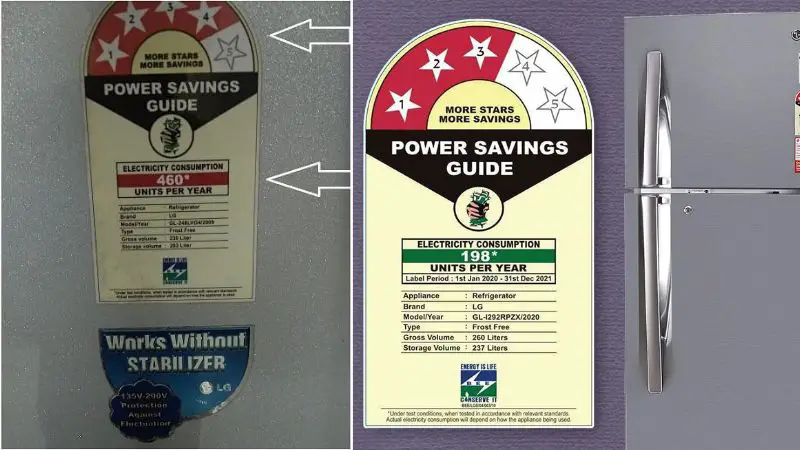
The image on the left is of my house refrigerator. It’s a 2010 model, 230 ltr, 4-star rated energy-efficient refrigerator from LG.
Its annual power consumption is 460 kWh, which is pretty good for that time.
The image on the right is of a 2021 model, 260 ltr, 3-star refrigerator from LG, its annual power consumption is just 198 kWh.
Hence, you can clearly see, in the last 10 years, the power consumption of a same-size refrigerator, from the same manufacturer, with a similar energy star rating has drastically reduced by more than half.
(Well my old fridge had 4 stars and the new one has just 3, but still, its power consumption is half of my old fridge).
Now imagine, you have a refrigerator from 2005, just replacing that with a new energy-efficient fridge will drastically reduce your electricity bill.
Hence, it’s safe to say, yes, old refrigerators consume a lot of electricity. In fact, old refrigerators consume almost two times more power than new refrigerators of similar size.
If you have reached this far, then it would be pretty clear to you that new modern refrigerators don’t consume a lot of electricity.
Still, there are ways you can reduce your refrigerator’s power consumption and save your electricity bill. Here are a few things you can do.
Factors affecting The power consumption of a refrigerator:
- Size of the refrigerator – A double-door fridge will consume more power than a single-door fridge. The larger the volume of the fridge the higher its power consumption it’s as simple as that. However, as we saw before bigger fridges are generally more energy efficient as they use less energy to cool a unit volume of space.
- Energy star rating– Refrigerators with higher energy star ratings are more efficient than their counterparts of the same volume. Also, If your refrigerator is made before 2005 then chances are it does not come with an energy star rating and is not as efficient as the new ones. We will discuss about energy star rating in detail in the later part of this blog.
- How full is your fridge– The more you stuff your fridge (to a limit guys) the less electricity it consumes because an empty fridge has lots of air which needs to be cool down in comparison to a fridge that is full hence the compressor has to cool down a large volume of air and hence consumes more power.
- Door opening frequency – Well this is one thing we all are guilty of doing, every time you open your refrigerator door warm air from the atmosphere gushes inside the fridge and heats up the cooled space. Hence the compressor has to work more to cool the inside of the refrigerator again.
- Ventilation of your refrigerator – This is neglected big time in all of our houses. The refrigerator basically removes warm air inside it and pumps it into the atmosphere, but if the refrigerator is not properly ventilated then the hot air surrounding it will heat the compressor and thus increase the power consumption.
Energy Saving Tips For Refrigerators:
- Keep the refrigerator full – This sounds bizarre but keeping your refrigerator full helps to cut down the power consumption. A full refrigerator does not mean overstuffing the refrigerator, it means a more organized fridge that has enough place for proper air circulation.
- Optimize temperature settings – Most of the refrigerators are running at temperatures way below whats needed. On average a temperature of 2 C to 5 C is ideal for the fridge compartment and for the freezer, anything between -10 C to -15 C is good. Don’t overdo the temperature. Just switch your refrigerator setting to normal on normal days and below normal on cold days (use the regulator inside your refrigerator).
- Keep the refrigerator door closed – Frequent opening and closing of the refrigerator door puts an unnecessary load on the compressor to cool the fresh warm air that enters the space every time you open the door. If you cut down your door opening frequency you will see a drop in your power consumption.
- Place refrigerator strategically – Two questions your should ask yourself before finalizing your refrigerator place. First, is the place getting direct sunlight? if yes, then look for some other place or restrict the sunlight coming to that place by some means. Second, after placing the refrigerator is there any space between the refrigerator walls and your house wall? Ideally, you should keep 6 inches of space on all three sides for proper ventilation. You can check out this awesome article from Samsung on how to place your refrigerator How much free space should I allow around my refrigerator?
- Lifestyle changes – Do not keep hot food directly in the refrigerator. First, let the food cool down and then put it in the refrigerator. Periodically clean the evaporator and condenser coils. Keep your food organized so that there is enough space for free movement of air.
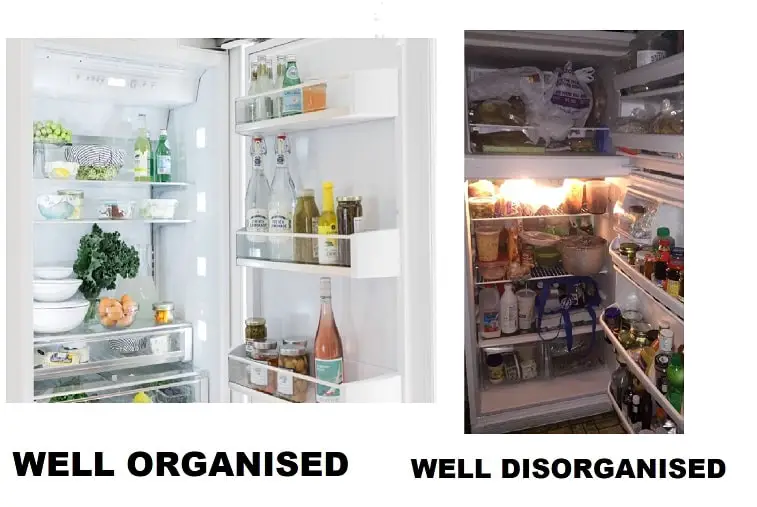
If you live in India or any place where a star rating is used on the energy-saving label, then the following information will be useful for you.
if not, then feel free to skip past this part.
How BEE star rating Affects A Refrigerators Power Consumption?
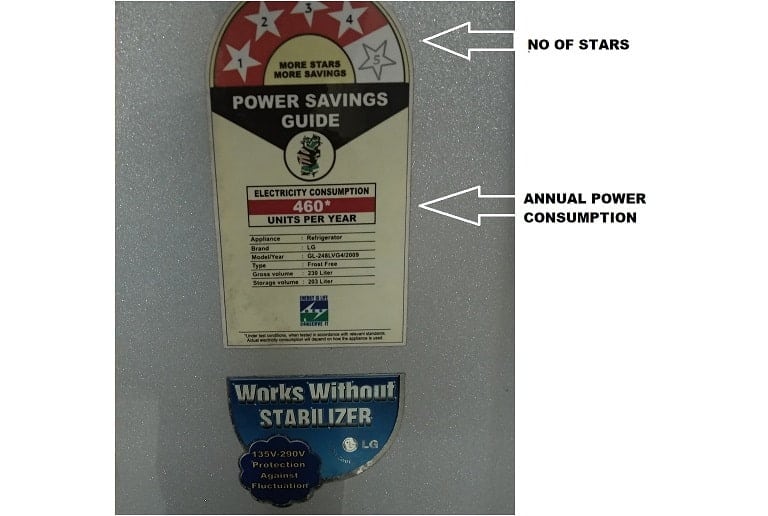
The Bureau of Energy Efficiency (BEE) star rating was introduced in India in 2006 to help signify the cost-saving and power-saving potential of electrical appliances.
The higher the star rating, the higher the appliance efficiency, and the lower the power consumption.
Along with the star ratings mentioned on the label, there is other crucial information like the annual power consumption of the appliance, brand name, manufacturing year, type of appliance, and other technical data.
Let us see how much difference in the power consumption you can expect from 1 star to 5 star.
For example, I have selected a 192-liter frost-free refrigerator from Samsung and shown its annual power consumption with different energy star ratings.
| Star Rating | Annual Power Consumption (kWh) | Electricity Bill | Refrigerators Cost |
|---|---|---|---|
| 1 Star | 254 kWh | Rs, 2,540 | Rs 12,490 |
| 2 Star | 203 kWh | Rs 2,030 | Rs 14,490 |
| 3 Star | 162 kWh | Rs 1,620 | Rs 14,990 |
| 4 Star | 130 kWh | Rs 1,300 | Rs 18,000 |
| 5 Star | 104 kWh | Rs 1,040 | NA |
From the above table, in Mumbai, the annual running cost of a 192 ltr, 1-star refrigerator is Rs 2,540 and its purchase cost is RS 12,490.
And the annual running cost of a 192 ltr, 4-star refrigerator is Rs 1,300 and its purchase cost is Rs 18,000.
Hence, if you buy a 4-star refrigerator you can save around Rs 1,240 every year and as the difference in cost is just Rs 5,500, you can recover the extra amount you paid in just 5 years.
I couldn’t find the power consumption of refrigerators without any energy-saving star, if I find it I will update it in the blog post.
Best refrigerator to buy in India:
All links are amazon affiliate links.
- Annual Power Consumption (168 kWh) Whirlpool 190 L 4 Star ( 2019 ) Direct-Cool Single-Door Refrigerator.
- Annual Power Consumption (234 kWh) Godrej 261 L 3 Star ( 2019 ) Frost-Free Double-door Refrigerator.
- Samsung 253 L 4 Star ( 2019 ) Frost Free Double Door Refrigerator.
- LG 687 L Frost Free Side-by-Side Refrigerator.
- Annual Power Consumption (500 kWh) Samsung 700 L Inverter Frost Free Side-by-Side Refrigerator
Conclusion on the power consumption of a refrigerator:
To conclude, modern refrigerators are energy-star rated and they come with energy-efficient inverter compressors, hence, they don’t consume a lot of electricity.
Generally, the annual power consumption of refrigerators can be as low as 100 kWh and as high as 500 kWh, which is not too high keeping in mind they run 24 X 7 throughout the year.
However, old refrigerators which are not energy-star rated, consume a lot of electricity.
A modern refrigerator will consume less than half of what a 10 – 15-year-old refrigerator will consume.
The power consumption of a refrigerator can be brought down by keeping it in a place that does not receive direct sunlight and by leaving sufficient space between the refrigerator and the house walls for proper ventilation.
If you liked this article then feel free to share it with your friends on Facebook, Pinterest, WhatsApp, and Reddit.
You can check out this article to know more about the power consumption of common household appliances.
Check out my articles on solar power for home and how it can help you save your electricity bill.
Check out the following articles to know the power consumption of other appliances:
- Power consumption of infrared heaters.
- Power consumption of water heater
- Power consumption of tankless water heater.
- Power consumption of an electric immersion heater.
- Power consumption of an electric kettle.
- Power consumption of an electric fireplace.
- Power consumption of a washing machine.
- Power consumption of air conditioner.
Thank you for reading.
Aavjo 👋
References:
- https://www.globalpetrolprices.com/electricity_prices/
- https://www.statista.com/statistics/263492/electricity-prices-in-selected-countries/
- https://www.samsung.com/in/microsite/single-door-refrigerators/
- https://www.lg.com/in/refrigerators
- https://www.beestarlabel.com/
- https://en.wikipedia.org/wiki/Bureau_of_Energy_Efficiency
- Double Door Refrigerator Power Consumption
 Share the article In this article, we will see double-door refrigerator’s power consumption and the cost […]
Share the article In this article, we will see double-door refrigerator’s power consumption and the cost […] - How to reduce air conditioner power consumption
 Share the articleSummer is here, and that means one thing: air conditioners are turned up to […]
Share the articleSummer is here, and that means one thing: air conditioners are turned up to […] - How To Save Electricity At School
 Share the articleElectricity consumption in schools is mainly because of two main sources of power consumption […]
Share the articleElectricity consumption in schools is mainly because of two main sources of power consumption […] - How To Reduce Power Consumption Of A Refrigerator?
 Share the articleIn this article, we will see how you can reduce your refrigerator power consumption […]
Share the articleIn this article, we will see how you can reduce your refrigerator power consumption […] - How To Calculate Power Consumption Of Any Appliance
 Share the articleEver wonder how much electricity the light bulb in your kitchen consumes or how […]
Share the articleEver wonder how much electricity the light bulb in your kitchen consumes or how […] - Top Load Vs Front Load Washing Machine
 Share the articleThe biggest question that came to my mind while choosing a washing machine last […]
Share the articleThe biggest question that came to my mind while choosing a washing machine last […]


